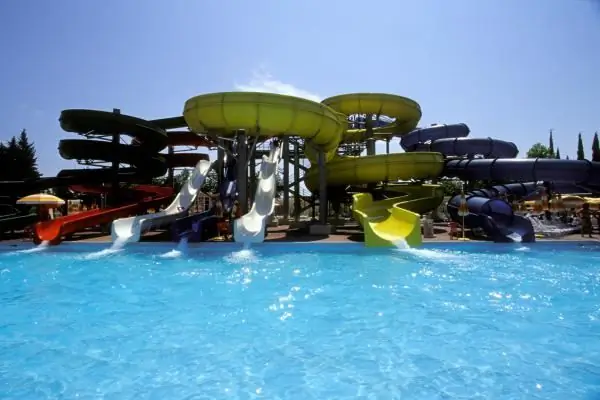- Author Harold Hamphrey [email protected].
- Public 2023-12-17 10:06.
- Last modified 2025-01-24 11:10.
The Turan lowland is one of the most interesting regions of Kazakhstan and Central Asia. Once upon a time, a huge sea stretched on this place, the modern remnants of which are the Caspian and the Aral Sea. At present, this is a huge plain, the territory of which is occupied by the deserts of the Karakum, Kyzylkum and others.
Where is the Turan lowland
The nature of this territory largely depends on the geographical location. The Turan lowland is located on the territory of three sovereign states - Turkmenistan, Uzbekistan and Kazakhstan. In the north-south direction, the lowland extends for 1.6 thousand km, and in the west-east direction - for 1 thousand km, occupying a huge area.
The name of the region comes from the word "Turan", "country of tours". This name is recorded in the sacred book of Zoroastrianism - the Avesta, which dates back to 1000 BC. Researchers suggest that the "tours" are steppe arias.
The region is rich in minerals (oil, gas, gold, sulfur andetc.), animal husbandry and irrigated agriculture are widely developed.
Relief
The relief of the Turan lowland is generally rather flat, with relatively small elevation differences. However, here the plains alternate with numerous uplifts and depressions. The lowest point of the lowland is the Karagie depression, the absolute height of which is minus 132 meters (located below sea level), and the highest point is Mount Tamdytau (0.922 km).

The average heights of the region are 200-300 meters above sea level. The most elevated area of the Turan lowland is the Kyzylkum desert with an average absolute height of 0.388 km. In ancient times, the Turan lowland was the bottom of a vast inland sea, the remnants of which today are the Aral and Caspian Seas.
The deserts of the Kyzylkum, Karakum are covered with sands with a pronounced eolian landscape. Here you can admire hilly sands, dunes and dunes.
Climate
The climate of the region, which is sharply continental and desert, is determined by its geographical features. Firstly, the Turan lowland is located in the heart of the continent. At a considerable distance from the oceans and moist air currents. Secondly, from the south and southwest, the Turan lowland is limited by mountain barriers, which weaken the circulation of air masses.
All this makes the region extremely arid and largely covered by deserts. At the same time, in the direction from north to south, the amount of precipitation hasdecreasing trend, and the amplitude of temperature fluctuations increases.
River system of the district
Due to climatic features, the river network of the region is extremely underdeveloped, represented mainly by the Syrdarya and Amudarya rivers flowing into the Aral Sea. It, in turn, is actually a lake in the Turan lowland. Moreover, in the last century, due to the active development of agriculture, the flow of the Amudarya has greatly decreased, and the flow of the Syrdarya has practically ceased, which caused the gradual drying of the Aral Sea and a lot of environmental problems.

The Syrdarya river of the Turan lowland divides the entire territory into two unequal parts - northern and southern. In addition to two fairly full-flowing rivers, on the Turan lowland in the southeast - northwest direction lies the dried-up channel of the Uzboy River.
Karakum
The Karakum desert ("black sand") occupies a huge area of 350 thousand square meters. km. The origin of the name may be related to the vegetation, which loses its green color in summer. And the sand dunes are called Ak-kum ("white sand"). The Karakum is also famous for the fact that the whole Temple city of Gonur-Depe was found in its sands, fire was worshiped here.

The desert is very arid and almost uninhabitable. 60-150 mm of precipitation falls here annually in various areas, with the vast majority of them (70%) falling during the cold season.

It's veryhot in summer, the temperature in some parts rises to 500, and the sand itself warms up to +80, making it completely impossible to walk barefoot on it. In winter, there are severe frosts here, sometimes the thermometer drops below 300 Celsius.
Despite the adverse weather conditions, numerous animals live in the desert - a turtle, a steppe cat, various rodents, scorpions, snakes, etc. In the northern part, in the clay deserts of the Turan lowland, saigas and goitered gazelles live. Perhaps the main attraction of the desert is the picturesque Darvaza crater, which the locals compare with a real door to hell.

The fact is that after the failed drilling operations and the failure of the drilling rig underground, gas began to rise from the ground, threatening to poison the nearby villages. In order to avoid this, it was decided to set fire to the gas. This is how a blazing 60-meter funnel appeared, the height of the flame escaping from it sometimes exceeds 10 meters.
Kyzylkum
This is the largest desert in Central Asia. On the territory of modern Kazakhstan is only its northern section.
The desert, whose name can be translated as "red sand", is located between the Syr Darya and Amu Darya. Its sands really have a reddish tint. They are of eolian and alluvial origin, have a Paleogene age. The desert occupies 300 thousand square kilometers. Endless sands here alternate with small remnant mountains (less than a kilometerheight). Sand massifs formed by the winds sometimes reach a height of 75 meters.
Unlike its Turan sister (Karakum), Kyzylkum is more favorable for life. Small cattle graze here, and thanks to artesian water and a canal from the Syr Darya, in some areas it is possible to harvest rice, grapes and fruits.






